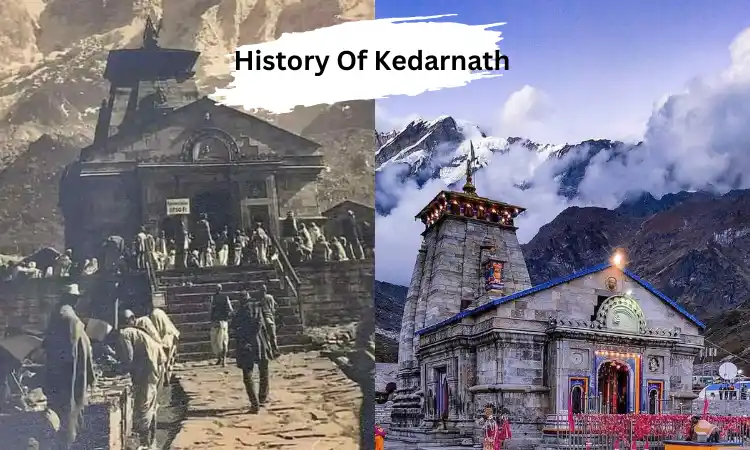Kedarnath, located in Uttarakhand, is one of the holiest pilgrimage places in India. It’s part of the Char Dham Yatra and many pilgrims feel that visi
Kedarnath, located in Uttarakhand, is one of the holiest pilgrimage places in India. It’s part of the Char Dham Yatra and many pilgrims feel that visiting Kedarnath brings them closer to salvation (Moksha). You’ll see snowy mountains, green valleys and flowing rivers all around. Because of Kedarnath history, this place has become more famous and meaningful for pilgrims.
Its history is mentioned in several historical books and writings. People from all over the world visit here to learn about it and find peace. In this guide, you’ll learn about its past and why Kedarnath is such an important spot for many pilgrims.

The Story Behind Kedarnath Temple – Pandavas and Lord Shiva
- Once the war of Mahabharat ended, the Pandavas went looking for Lord Shiva to ask for forgiveness for killing their own family members.
- Lord Shiva didn’t want to meet the Pandavas. So, he turned into a bull and hid in the Himalayas.
- The Pandavas found the bull hiding in the Himalayas and they tried their best to stop it.
- The bull tried to run away, but Bheem quickly caught its hump, while the rest of its body disappeared.
- The hump stayed in that spot, and today, the Kedarnath Temple stands right there.
- The other parts of the bull’s body appeared in different places, and together, these five places are known as Panch Kedar.
- Lord Shiva saw the Pandavas’ true devotion and forgave them. As a result, they built the Kedarnath Temple at that spot.
Architecture of Temple
- Kedarnath Temple is very old and built high in the Himalayas. It was made strong enough to face tough weather and still looks beautiful today.
- Large stones were used to build the temple joined without cement; only strong iron clamps hold them together.
- The temple is built in the Nagara style, a traditional design from North India. It has two main parts- the inner room where Lord Shiva is worshipped and hall where people come together.
- The Lingam here is special, a naturally cone shaped rock. At the entrance, you’ll also see Nandi, the sacred bull of Lord Shiva.
What Makes This Temple Special
- Hindus believe that Lord Shiva showed himself in the form of Jyotirlinga. Out of 12 Jyotirlingas, this one is very important.
- It is believed that the Pandavas first built the Kedarnath Temple, and then Adi Shankara renovated it in the 8th century AD.
- Kedarnath Temple is very old, it’s been here for more than 1,000 years.
- The name “Kedarnath” comes from two Sanskrit words – “Kedara” meaning “field” and “Natha” meaning “lord.” That’s why it’s called the “lord of the field.”
Nara and Narayana’s Devotion to Lord Shiva
- Nar and Narayan, the twin sages believed to be forms of Lord Vishnu, once came to the Himalayas for deep meditation. They chose Kedarnath’s peaceful surroundings and they prayed to Lord Shiva with full dedication for many years.
- It is believed that they requested Lord Shiva to stay at Kedarnath forever, and he accepted their request.
Kedarnath Temple Was Under Snow for 400 Years
- Geologists believe that from around 1300 to 1900 AD, the temple was under the ice for nearly 400 years, during the Little Ice Age.
- Scientists from the Wadia Institute of Himalayan found yellow lines on the temple walls that show effects of glaciers.
- Although the temple was buried in snow, it was not badly damaged. Inside, the stones look brighter because of movement of glaciers.
- Scientists also observed that the temple was built to fit the land and survive natural disasters, which helped it stay strong over the years.
2013 Floods
- The Kedarnath valley, along with other areas in Uttarakhand, was badly affected by sudden flash floods on June 16 and 17, 2013.
- Thousands of people died, and the area was heavily damaged. Miraculously, the temple was unharmed, even with all the damage around it.
- Many people believed that it was Lord Shiva’s divine power. After the disaster, the government and local officials worked hard to rebuild the city and nearby areas.
Restoration and Rebuilding After the 2013 Kedarnath Floods
- The Indian government provided funds and started rebuilding both the temple and the town around Kedarnath.
- Pilgrims now have a spacious and comfortable path to walk to the temple, where they can see the mountains clearly. Vehicles are not allowed there.
- After the flood destroyed the original route, a new walking path was opened, and a bridge was built.
- Protective walls were constructed near the river to stop damage from future floods.
- To improve the pilgrim’s journey, new meditation caves were built, eco-friendly toilets, and traffic is now well managed.
- Soon there’ll be a memorial for those lost in the floods, a cable car to make the trek easier, and a light show that shares Kedarnath’s history.
Conclusion
Kedarnath is not only known for its temple, but also for the many stories and strong positive vibes. The story of the Pandavas and Lord Shiva, along with Nar and Narayan’s prayers, makes Kedarnath a very holy place. The history of Kedarnath is so special that many people come from far away just to learn about it. This shrine has faced strong storms, heavy snow for hundreds of years, and even the big 2013 flood but it still stands strong today. Many people feel peaceful and close to God when they come here. Kedarnath is still improving, with smoother walking paths, peaceful meditation caves, and exciting plans like a cable car and a light show.
COMMENTS